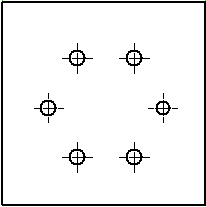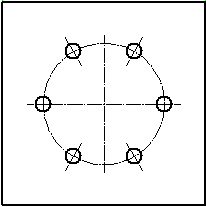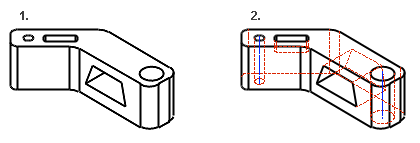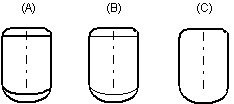The dialog box is opened when you add a new projection model in the drawing.
 New Projection
New Projection
Select the properties of the new projection.
- Projection Name / Header / Scale / Configuration -
 Projection Name/Header Data
Projection Name/Header Data
- Projection –
 Projection
Projection
- Show from Model –
 Projection
Projection
- Drawing Mode –
 Drawing Mode
Drawing Mode
- Automatic Dimensioning –
 Automatic Dimensioning
Automatic Dimensioning
- Tangential Lines -
 Tangential Lines
Tangential Lines
------------------------------------------------------------------------------------
New Projection Dialog BoxProjection Name/Header Data
The projection is named automatically. The name is formed from the name of the model and projection, for example.
- Header
- The title text will be set as the title of the projection. The title is defined when creating a detail view, section view or a new projection. The title text and its position can be edited.
 Move Text from a Grip Point
Move Text from a Grip Point- Scale
- The default projection scale is 1:1. Select a suitable scale. When the projection is a detail view or a section view, the projection scale will be displayed in the title.
- Scale: autofree or autofix – Dynamic projection
- The projection area can be defined so that it is drawn inside the selected rectangle always, by the function
 Continuous line chain.
Continuous line chain.
- This is useful when the drawing represents a model whose dimensions vary greatly. In this way, the projection stays in the right place at all times, and the scale is defined in such a way that the geometry fits inside the rectangle.
 If you draw the rectangle with the function
If you draw the rectangle with the function  Rectangle,
Rectangle,  Open Polyline or
Open Polyline or  Closed Polyline, the line chain is not continuous. Make the line chain continuous with the function Line Trimming>
Closed Polyline, the line chain is not continuous. Make the line chain continuous with the function Line Trimming>  Concatenate Lines. If you wish to hide the rectangle, move the continuous line chain to layer 110 (hidden layer).
Concatenate Lines. If you wish to hide the rectangle, move the continuous line chain to layer 110 (hidden layer). Concatenate Lines
Concatenate Lines- If you select either Autofree or Autofix as the scale, the program will ask you to indicate a continuous rectangle line that defines the projection area limits.
- The projection is scaled to the area defined by the rectangle in accordance with the calculated scale, or the projection finds the preselected scale that best fills the area, but does not cross its boundaries. When updated, the projection is always scaled in accordance with these rules.
- Autofree - The projection is scaled to the area defined by the rectangle, based on the calculated scale.
- Autofixed - The projection looks for the preselected scale that best fills the area but does not cross its boundaries.
 You can reduce the size of the projection by reducing the size of the projection line (drag and drop).
You can reduce the size of the projection by reducing the size of the projection line (drag and drop).- The scales are defined in the settings using the keywords scale -1, Auto free and scale -2 Autofixed.
 Edit Settings
Edit Settings
- Configuration
- Select the configuration for the part displayed in the projection. If in addition to the basic configuration (0: Configuration) there are also other configurations, select the configuration which is displayed in the projection to the field.
 Add a Configuration to a Part
Add a Configuration to a Part
 Add a Configuration to an Assembly
Add a Configuration to an Assembly Flattening is a configuration of a sheet-metal part. The configuration of a flattening view cannot be changed.
Flattening is a configuration of a sheet-metal part. The configuration of a flattening view cannot be changed.- If you select
 Perspective, automatic dimensioning cannot be selected.
Perspective, automatic dimensioning cannot be selected.
------------------------------------------------------------------------------------
New Projection Dialog BoxProjection/Show from Model/Set Viewing Direction
Select a projection from the list.
As an example: front, top, etc.
Select Show from Model: Indicate the model face to define the direction of the projection.
If you select  Perspective, automatic dimensioning cannot be selected.
Perspective, automatic dimensioning cannot be selected.
If you select Set Viewing Direction, define the viewing direction in the dialog box as angle values Alpha, Beta, Gamma and click OK.
The default value iis (A: 0, B: 0, G: 0).
------------------------------------------------------------------------------------
Drawing mode
- Drawing mode
- The default drawing mode of the projection in a model drawing is Wire frame, unless another drawing mode was selected when creating a new drawing from the model. You can also select the drawing mode of a perspective projection in the drawing.
- Select the drawing mode for the projection.
- Wire Frame
- OpenGL shading If you wish that a model's edges are drawn in the projection when using this drawing mode, select Advanced.
- OpenGL Shading+ wire frame When this drawing mode is selected, you can dimension any other projection except a perspective projection. You can soften the drafting of the lines by selecting Antialiasing.
- LightWorks Shading (add-on) When this drawing mode is selected, the projection also includes shadows. You can remove the shadows from the projection by selecting No shadows.
- Lightworks Shading+ wire frame (add-on) When this drawing mode is selected, you can dimension any other projection except a perspective projection.
- Advanced
- Can be selected for all other drawing mode except Wire Frame.
- You can define a maximum size in pixels of the image rendered to the projection when using OpenGL and LightWorks Shading drawing modes at Max size in pixels. The recommended pixel resolution is 2000, at most 6000. The larger the pixel resolution value, the greater the detail in which the projection will be rendered. For paper printouts, 2000 pixels is usually a sufficient resolution. Note that a high resolution makes the projection update in the drawing slower. You can also select: Anti-aliasing, Remove Background and/or OpenGL Sihouette Lines.
- In PDF and PostScript (driver code 7 5) printing, projections shaded and visualized with resolution value 0 have their original resolution in the printout regardless of the sheet size used in printing.
 Exact Silhouette Lines
Exact Silhouette Lines- The silhouette lines (edge lines) are drawn exactly.
 Coarse drawing speeds up refreshing the projections, but, for example, the dimensioning of an arc will fail.
Coarse drawing speeds up refreshing the projections, but, for example, the dimensioning of an arc will fail.
 Also for spline surfaces
Also for spline surfaces- Precise silhouette lines (edge lines) are drawn for the part's spline faces.
 Center Lines
Center Lines- Center lines are automatically drawn for circles and arcs. Center lines of the arc will be drawn when the arc sector meets the minimum default value: 180 degrees. You can change the value of the sector projection-specifically. Center lines will be drawn in the projection of a part drawing, even if the
 Center Lines option is unselected when creating a new drawing.
Center Lines option is unselected when creating a new drawing.
- You must specifically select
 Center Lines in the projection of an assembly drawing, if it has not been selected when creating a new drawing of a model.
Center Lines in the projection of an assembly drawing, if it has not been selected when creating a new drawing of a model.

- The center lines of a polar hole pattern
- The drawing of polar hole patterns follows the mechanical engineering rules.
- In the sketching mode, define the radius of the feature pattern to the desired value, if you have used the default value (R100).
 The radius is displayed in the projection if
The radius is displayed in the projection if  Auxiliary geometry is selected.
Auxiliary geometry is selected.- If you select the two following options, the center lines of the part will be drawn in the projection through all the geometry. Can also be selected for pipe parts.
- Center Lines
- Auxiliary Geometry

- Hidden Lines
- The hidden lines are drawn with dashed lines.
- As an example, a part model.
- Hidden Lines – No hidden lines.
- Hidden Lines – Hidden lines visible.

- Colored Hidden Lines - You can define the color of the dashed lines being hidden in the Settings.
 Define the Color of Hidden Lines
Define the Color of Hidden Lines

- Auxiliary Geometry
- You can set the auxiliary geometry of a model to be displayed in the projection. Auxiliary geometry is 3D sketches, guide curves, and cross-sections.
- As an example, the guide curve controlling the shape of a handle.
- Auxiliary Geometry (visible)
- Auxiliary Geometry

- Tool Features
- A machining feature is displayed in the projection if you select
 Machining Features. The visibility of a machining feature in an assembly has no effect on a projection of a model's drawing.
Machining Features. The visibility of a machining feature in an assembly has no effect on a projection of a model's drawing.
 Machining Feature
Machining Feature Also pipe parts
Also pipe parts- The center lines of pipe parts will be visible in the projection.
 The visibility of the pipe part center lines is also affected by the projection property Auxiliary Geometry.
The visibility of the pipe part center lines is also affected by the projection property Auxiliary Geometry.- If you select both, the pipe part center lines will be drawn in the projection through all geometry.
- Center Lines
- Auxiliary Geometry If you do not select Auxiliary Geometry, hidden lines (center lines of pipe parts) will be removed from the projection.
- Automatic Dimensioning
- You can add dimensions to an active projection of a drawing automatically.
- Select a projection from the model drawing.
- Select the context-sensitive function Properties.
- Select Automatic dimensioning.
- Click the Settings button and define the dimensioning settings.
- Click OK.
 Automatic Dimensioning
Automatic Dimensioning- Tangential lines
- Apparent shape lines will be created between tangential faces. Select drawing as a shape line or thin line, or disable the drawing of tangential lines in the projection.
- As Shape Line (default) (A)
- As Thin Line (B)
- Lines Are Not Drawn (C)

- You can select the drawing of tangential lines specifically for each drawing. The setting is not saved in a drawing.
 Projection Name/Header Data
Projection Name/Header Data Projection
Projection Projection
Projection Drawing Mode
Drawing Mode Automatic Dimensioning
Automatic Dimensioning Tangential Lines
Tangential Lines Continuous line chain.
Continuous line chain. Perspective, automatic dimensioning cannot be selected.
Perspective, automatic dimensioning cannot be selected. Exact Silhouette Lines
Exact Silhouette Lines Coarse drawing speeds up refreshing the projections, but, for example, the dimensioning of an arc will fail.
Coarse drawing speeds up refreshing the projections, but, for example, the dimensioning of an arc will fail. Also for spline surfaces
Also for spline surfaces Center Lines
Center Lines Center Lines option is unselected when creating a new drawing.
Center Lines option is unselected when creating a new drawing. Machining Features. The visibility of a machining feature in an assembly has no effect on a projection of a model's drawing.
Machining Features. The visibility of a machining feature in an assembly has no effect on a projection of a model's drawing. Also pipe parts
Also pipe parts



 Concatenate Lines
Concatenate Lines




